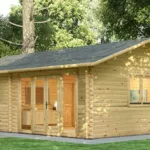It wasn’t so long ago we brought you word that Dutch Docklands was bringing a new floating hotel to the Maldives, one of the island nations on the front lines of the fight against global warming.
Now the architect behind that project, Koen Olthuis, and his building partners at Dutch Docklands have turned their attention to Norway, where they envision a 5-star floating hotel “in one of the most beautiful natural surroundings on earth.”

The design for the Krystall, as it’s known, is based on the shape of an ice crystal — resembling, perhaps, a particularly beautiful iceberg, floating among the fjords. The hotel will have 86 rooms, conference rooms, spa and wellness facilities, and was designed to be completely self supporting and self-sustainable.
Details on the green technology behind this claim have yet to be established, but you can download a lovely concept video for the hotel, slated for installment off the coast of Tromsø. In it, you’ll float through hallways lined with cool, futuristic blue shapes; recline by a fireplace faced in transparent bricks resembling ice-blocks; sleep in rooms tricked out in minimalist, winter-themed designs; and recline in a conference featuring the latest in Jetson-style seating. You’ll also gaze out of a curtain wall of windows at the forested, snow-dusted coast of Norway, and perhaps even glimpse the Northern Lights.
VisitNorway.us characterizes Tromsø as “a lively, humorous and beautiful city packed with culture and history, and surrounded by mountains, fjords and islands.” We imagine something, perhaps, has been lost in translation, but you get the picture: this is a destination city for Norwegian tourism, and probably a pretty cool place to spend some time in a floating hotel.
Reuters reports that Olthius, the architect behind both Krystall and Greenstar (the Maldives’ floating hotel), started off small: when he graduated from architecture school and got his first job at a firm, the powers that be weren’t interested in handing over any accounts involving those historic or prestigious accounts located in Amsterdam’s city center (which dates back to the 17th century). Instead, he got houseboats, which were essentially floating boxes.
But Olthius, whose heritage includes both boat building and architecture, embraced the challenge of building better buildings that float, and eventually made the connection between the principles of the floating house and the battle the Dutch have been waging against the sea to stay dry for the last 500 years. In doing so, he arrived at a key critique.
“I am a Dutchman, and for me, Holland is an artificial country,” he told Reuters‘ Roberta B. Cowan. “It is all fake. We live below sea level and it takes too much effort and money to keep the pumps working 24 hours a day.”
He goes on to note that within 50 years, it won’t even be possible to pump all the water back to the sea, and it will be time for the Dutch to forge a new relationship with water. “We need to learn to live with it rather than fight it. We should let the water come back, and then build on it.”
Dutch Docklands has already designed some lovely floating buildings in the Netherlands, but the country as a whole, it seems safe to say, has yet to fully embrace Olthius’ vision. If the Krystall is built in Tromsø, perhaps more developers in Holland (and in other coastal countries worldwide) will begin to take note.






